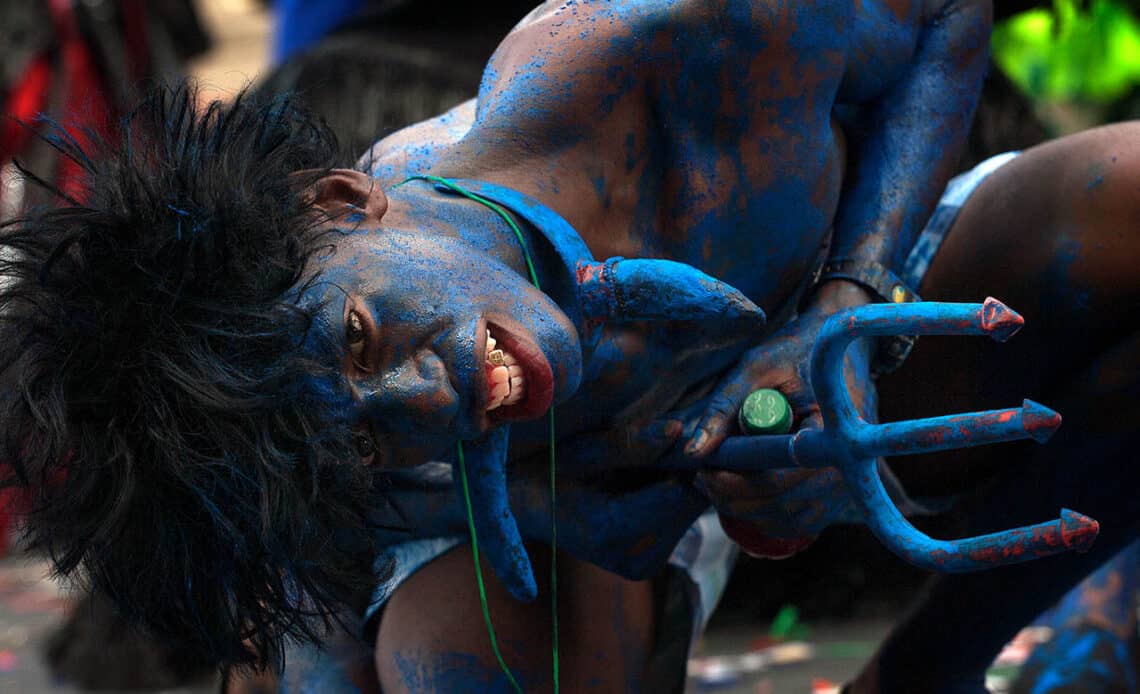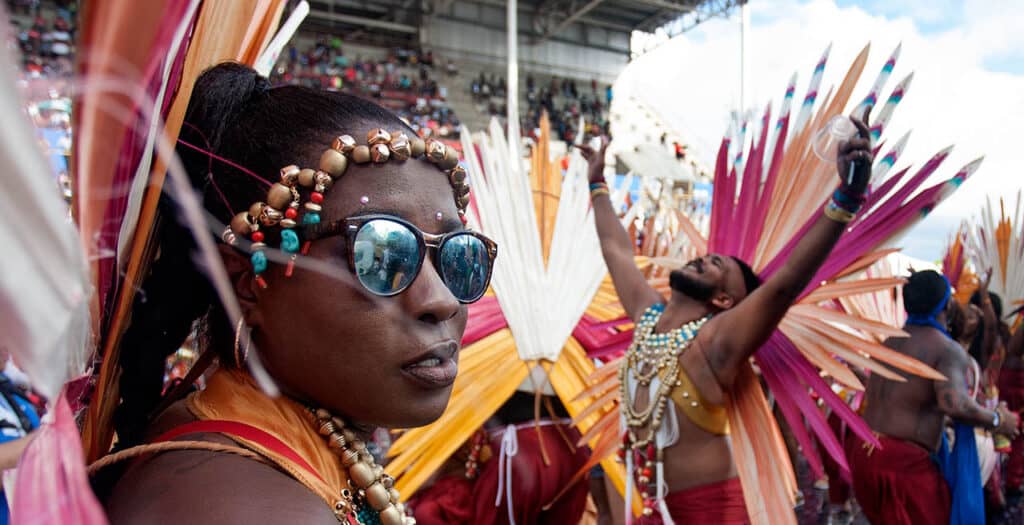
Above: A blue devil performing at the Socadrome in 2017. Photo by Mark Lyndersay.
BitDepth#1394 for February 20, 2023
There have always been three essential tensions that define the planning, production and success of Trinidad and Tobago’s Carnival – the political, the commercial and the creative.
When these sometimes hotly competitive interests array themselves in interesting conflicts and agreements, the festival springs to life.
This is also where things can go dramatically wrong and when they do, it’s often with the best of intentions and in the interests of “de culture.”
Culture is a word that gets tossed around a lot in discussions about Carnival, often alongside tradition.
But tradition, by definition, is the process of continuing to do something in a particular way because it’s always been done that way.
Culture, conversely, is a reading of the current ideas, customs and behaviours of a human collective, normally viewed as an evolution over time.
Carnival originated in a challenge to entitled authority by underserved social classes that played out in visual allegory, chantuelle and defiant iron rhythm. In each of those early years, the balance of power shifted decisively in favour of creative potential.
But what happens when them becomes us? When the lines of conflict disappear and there is no clear idea where they should be redrawn?
What happens when the oppressed become the gatekeepers of a cultural heritage that’s central to perception of national character?
These considerations should have been part of the deliberations of the Carnival Development Committee and its successor, the National Carnival Commission (NCC).
Both bodies, at least until the NCC finally conferred more decision-making power to TUCO, Pan Trinbago and the NCBA, exercised complete control over the shaping of Carnival events between 1957 and 1991.
Stakeholder bodies were empowered when the National Carnival Commission Act became law, but it would take years for these representative agencies to effectively take control of their slices of the festival.
When that happened, it soon became clear that yearning for power was not the same as wielding it.
Stakeholder agencies began demonstrating signs of pervasive kleptocracy, including a continuing reluctance to account for the massive sums granted for the production of events under their control.
The state’s unwillingness to insist on proper accounting only fed the fiscal frenzy.
In those circumstances, what had once been expressly creative became strategically political, and the State funded spending on Carnival became an opportunity for the establishment of constituencies, a process that renounces the individual in favour of a servile collective.

Over the 40 years that I’ve observed the festival, the changes have been profound, but always incremental.
Old Mas, an arena for brutal punning and scatological humour – once so popular that major Carnival parties began with the staging of mini-competitions – dwindled to a forgettable shadow of itself. Today it’s unruly shout is barely a whisper before the mud and paint explosion of modern J’Ouvert.
Brassorama, a defining tournament between the prevailing road bands of Carnival collapsed into a parody of self-indulgent arrangements that veered between the aspirational and the desperate, losing its audience and its niche in the lead-in to the festivities.
Carnival 2023 exposes new fault lines in the festival.
Calypso tents continue their slow slide into state-funded obscurity even as soca’s heirs begin recasting the conversation about how music is presented during the season.
Pan commands a shrinking audience which gathers only around the increasingly irrelevant idea of competition among creators.
Carnival at its core is competitive, but pureeing it through competitions at inadequate venues using dubious and secretive criteria has moved from being dated to being dangerous.
The State’s hand on the balance of Carnival is heavy, and its lazy insistence on spending taxpayer money to foster pointless rivalry is demonstrably destructive.
Merit based grants for small creators and community carnival arts projects that fertilise the next generation of artists and artisans should replace these pointless jousts for cash prizes and shoddy trophies.
State level investment has, for instance, nurtured dozens of calypsonians through school calypso tournaments, but these young bards face a world in which their hard-won skills have diminishing outlets.
The humiliation of Desperadoes having to leave their Laventille home is potentially the greatest indicator of the diminishing presence of the steelband as a vector for coalescing community.
Yet there are individuals, some acting collectively, insisting on creation and personal choice in the execution of the festival.
Agency is to be found across a range of actors, from Dean Ackin’s customer-focused Tribe to the insouciance of Robert Young’s Vulgar Fraction and the whimsical ferocity of Tracey Sankar-Charleau’s individual masquerades.
While the talk continues about evolving Carnival, the festival transfigures itself, straining against the tropes that we insist on using to contain it.
State and commercial interventions must identify and nurture the seeds of creation that will inspire future generations and find the courage to stop propping up dead limbs that will never again bear fruit.
Creators must leggo and get on bad, turning away from what is expected toward what makes sense in growing the event as an outlet for the creative.
What motivated the creation of Carnival doesn’t exist anymore, and the tensions that both drive and bedevil our society remain in place.
Calypso must resume its informed, witty talk-back to power, the steelband must reignite its role as a nexus for communities.
It’s arguable that the masquerade already mirrors a society obsessed with the shiny and objectively beautiful, but support for other visions and interpretations is lacking.
To get big on the festival, Carnival’s administrators and creators must begin by thinking small, returning to the spark of inventiveness that birthed the event and fanning the remaining embers back into a blaze capable of consuming the world.


